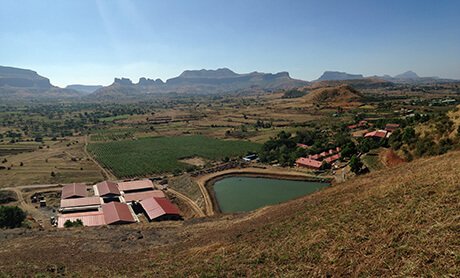The yoga as stated by Patanjali is enumerated through Sanskrit and hence contains only the main and the important thoughts. The first aphorism of the first Pada(part), introduces yoga as :
Atha Yoganushasanam | 1.1
That means the anushasan of yoga (description) is stated henceforth. That is to be understood and followed. The next aphorism states the purpose of the yoga :
Yogas chitta vritti nirodhah | 1.2
This means that yoga means controlling the thought waves of the mind. The thoughts, feelings, emotions arising in the mind are vrittis (nature), which should be controlled. This is called yoga. The broader perspective is expected and the word Chitta here means Individual consciousness, which covers all states conscious, sub conscious and unconscious.
While trying to control the vrittis (thoughts, emotions, feelings), certain disturbances are created which stop or divert the growth. Patanjali has addressed them as "Antaray(Disturbances) creating chitta vikshepa". These are described as under :
Vyadhistyan sanshay pramad alasya virati bhranti darshanalabdha bhoomi katvanavsthitatvani chittavikshepasteantarayah | 1.30
The aphorism describes nine Disturbances in all. We will consider them one by one.
This stage is different from the naturally healthy body or mind. Certain undesirable changes are observed in the body or the mind, which are harmful. To remove these changes, the entire strength is to be concentrated which can hinder the progress of yoga. It is experienced by all that if there are diseases or any ailments of the body, the asanas cannot be performed properly. The study of yoga can be continued when these diseases are cured. The main reason behind such diseases is the imbalance in the seven dhatus in the body, the controlling doshas - kapha, vata, pitta, the five sensory organs, the five organs of action and the mind. When the balance is restored, the diseases vanish. Many procedures in yoga are useful for retaining the balance.
Styan means the laziness of the chitta, or the drowsiness of the mind. The mind does not believe in karma or action and then there is a tendency not to do anything. Due to this, the studies of yoga are stopped or not undertaken. The laziness of the body is not considered here as it is separately stated under the head Alasya. Here, the mental and logical refrain towards the actions is aimed at.
If there is a doubt in the mind whether it will be possible to undertake something and succeed in it, it serves as an important hindrance against starting the thing. " Samshayatma Vinashyati " is known to all, which means that doubt leads to destruction or eradication. To achieve something, first we must have self-confidence regarding our abilities. Such confidence gives the required mental strength to succeed in the endeavor. But if we have doubts in our mind, it leads to destruction of the self-confidence. This in turn leads to inadequate mental strength behind the efforts. When the doubt arises, it continues to increase and then the efforts are totally wasted. This leads to inaction and no achievement. If there is a doubt in the mind regarding the path of the yoga, then it is not possible to progress further. Thus, the doubt is a major hindrance in the studies of the yoga.
A mistake made deliberately even after understanding its implications is carelessness. The mind understands the strategy to be followed for achieving something, but there is no action to achieve it. Such mistake is pramad, which stops us from doing something, which is essential. The studies of yoga do guarantee favorable returns and hence the desired results, is thoroughly understood, but still no action is undertaken to pursue the study. This is pramad, a hindrance in the progress.
The body and the mind is turned towards inaction, i e laziness. Even if all the abovementioned hindrances are removed, and if there is laziness, then there will be no karma or action and hence no progress. For progress in yoga, the necessary procedures are to be repeated again and again. Due to laziness, this becomes impossible and the progress is stopped. Mental strength and the firmness is essential to remove laziness.
Rati means to enjoy. The organs desire to have pleasurable perceptions. To allow them to engage in such perceptions is rati. The opposite of this is virati that means virakti. Virati means to control the organs from running behind such perceptions and not to let them immerse themselves in things, which yield the perceptions. If there is no virati, the organs will continuously run behind different matters. Mind runs behind the organs and this causes hindrance in the yoga. Absence of virati is avirati. To overcome this, control should be exercised and gained on the organs.
While studying yoga, sadhaka experiences various things. However, wrong interpretation of such experiences leads the sadhaka to the wrong path, stopping his progress. During the study of dhyana, certain sounds are heard or some scenes are visualized. Sadhaka may think that this is awakening of the Kundalini shakti. However, these experiences are not of awakening Kundalini Shakti. To believe such a thing is misinterpretation. Many such hallucinations may be experienced. If they are not interpreted by the sadhaka thoughtfully with the help from his guru, they may lead him onto the wrong path.
At every stage and procedure of the yoga, the sadhaka can experience the results. However, the duration of the practice required to get the results is different for each sadhaka. Some may experience the results immediately; some may take a long time. If to experience the results at any stage, a longer duration is required or if in a particular duration, the results are not experienced, then the sadhaka starts doubting the studies, which may lead to its stoppage. This attitude is alabdhabhoomikatva. The experiencing of the results is relasted to the duration and this comparison leads to this hindrance. So in spite of other conducive elements, the study is stopped.
Even after achieving a particular stage, inability to remain firmly in that stage is anavasthitattva. In all the yoga procedures, right from the physical procedures such as asana to the mental procedures such as samadhi, it is essential to remain firmly in a particular stage for some time after achieving that stage. The faith of the sadhaka and the intensity of the practice determine this. If it is not possible to stay firmly in the stage, doubts arise about the sadhana which disturb the yoga studies and may stop them altogether too. Hence, special efforts should be made to stay in the stages firmly. The unwavering faith of the sadhaka can easily remove this hindrance.
Thus, Patanjali has described nine types of the hindrances. This description is representative of his views. We experience the hindrances even in daily practice of yoga. One should familiarise oneself with such hindrances and try to overcome them so as to ensure the progress. Sadhaka should have doubtless faith on the path of the yoga and he should try to follow it religiously to overcome the hindrances.
All these hindrances cause disturbances in the mind (vikshepa of chitta) and cause certain effects. Patanjali has stated such effects in the following sutra :
Dukkhadormanasyaangmejaytvashwasprashwasa vikshepsahbhuvh | 1.31
All these are termed as experiences due to vikshepas.
The first experience or the result is pain. The pain may be physical or mental. If it is not possible to overcome the hindrances in following the path of yoga or if it is not possible to achieve the target, it causes disappointment. The disappointment is termed as Dourmanasya. Due to the hindrances, at times control over the organs cannot be gained and the body does not cooperate in the studies of the yoga. This is aangmejaytva. This results in loss of control over breathing too and stops the progress.
To remove the hindrances and their accompanying results Patanjali has given the guidance in the following aphorism :
Tatpratishedharthamekatatvabhyash | 1.32
That means to remove the hindrances, there should be Ektattvabhyas i.e. concentration. Concentration also means indomitable and doubtless faith on the path of yoga. Patanjali has suggested that with such unwavering faith and concentration only, all the hindrances can be overcome and the ultimate aim can be achieved. While describing the details of this ektattvabhyas Patanjali has clarified the ashtang yoga path with the Yam and Niyama.
Phone - +91-9822770727
E-mail - yoga@yogapoint.com or yogapoint108@gmail.com

Yoga Vidya Dham, Kaivalya Nagari,
College Road, Nashik - 422005.
Maharashtra, India.
Phone - +91-9822770727 (for courses in ENGLISH)
+91-253-2318090 (For courses, in HINDI or MARATHI)
(Please call during 9.00 AM to 5 PM Indian Time)
E-mail - yoga@yogapoint.co or yogapoint108@gmail.com
Village Talwade, Trimbak, Nasik
Maharashtra,India.
Phone - +91-9822770727
E-mail - yoga@yogapoint.com or yogapoint108@gmail.com
